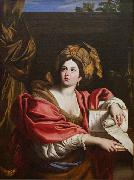Wholesale Oil Painting No Minimum |
|||||||||||
|
|
|||||||||||

|
|||||||||||
|
|
|
||||||||
EYCK, Jan vanFlemish Northern Renaissance Painter, ca.1395-1441 Painter and illuminator, brother of Hubert van Eyck. According to a 16th-century Ghent tradition, represented by van Vaernewijck and Lucas d'Heere, Jan trained with his brother Hubert. Pietro Summonte's assertion (1524) that he began work as an illuminator is supported by the fine technique and small scale of most of Jan's works, by manuscript precedents for certain of his motifs, and by his payment in 1439 for initials in a book (untraced) for Philip the Good, Duke of Burgundy. Jan is first documented in The Hague in August 1422 as an established artist with an assistant and the title of 'Master', working for John III, Count of Holland (John of Bavaria; reg 1419-25), who evidently discovered the artist while he was bishop (1389-1417) of the principality of Liege. |
||||||||
|
|
||||||||
Cumaean Sibyl
Cumaean Sibyl Painting ID:: 32328 |
1432
Oil on wood 1432 Oil on wood |
|||||||
|
|
||||||||
Domenichino1581-1641 Italian Domenichino Locations Italian painter and draughtsman. On the basis of his frescoes and altarpieces he became established as the most influential exponent of the 17th-century classical style. Through his critical analysis of the art of Raphael and Annibale Carracci he was influential in the creation of a modern canon of the ancients; and he was perhaps the most complete example of a 17th-century artist struggling to reconcile tradition with the demand for spectacle. |
||||||||
|
|
||||||||
|
|
Cumaean Sibyl
Cumaean Sibyl Painting ID:: 82059 |
ca. 1622(1622)
Medium Oil on canvas
cyf ca. 1622(1622) Medium Oil on canvas cyf |
||||||
|
|
||||||||
|
Domenichino 1581-1641 Italian Domenichino Locations Italian painter and draughtsman. On the basis of his frescoes and altarpieces he became established as the most influential exponent of the 17th-century classical style. Through his critical analysis of the art of Raphael and Annibale Carracci he was influential in the creation of a modern canon of the ancients; and he was perhaps the most complete example of a 17th-century artist struggling to reconcile tradition with the demand for spectacle. Cumaean Sibyl ca. 1622(1622) Medium Oil on canvas cyf |
||||||||
|
|
||||||||
|
Prev Next
|
||||||||
|
|
||||||||
|
Related Paintings to Domenichino :. |
||||||||
|
|
||||||||
|
CONTACT US |


